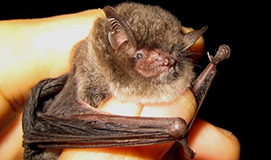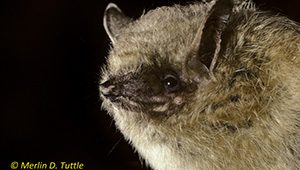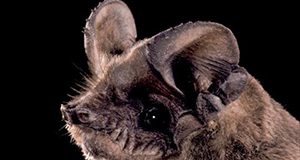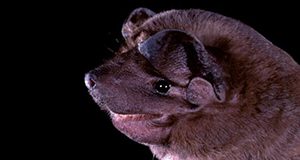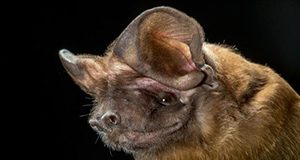The southeastern myotis is a small forest- and cave-dwelling bat that lives in Florida. Unlike many other species in Florida, southeastern myotis have long hairs between their toes that extend past their claws. You can learn to distinguish the southeastern myotis from other bats commonly found in Florida in this three-page fact sheet written by Emily Evans, Terry Doonan, and Holly Ober and published by the UF/IFAS Department of Wildlife Ecology and Conservation.
http://edis.ifas.ufl.edu/uw433
Tag: Terry Doonan
Florida's Bats: Tricolored Bat
The tricolored bat, formerly known as the eastern pipistrelle, is the smallest bat found in the state of Florida. It weighs just about as much as a nickel and a penny. Because of their small size and erratic flight pattern, tricolored bats are often mistaken for moths when seen in flight from a long distance away. You can learn to distinguish the tricolored bat from other bat species found in Florida with this three-page fact sheet written by Emily Evans, Terry Doonan, and Holly Ober and published by the UF/IFAS Department of Wildlife Ecology and Conservation.
http://edis.ifas.ufl.edu/uw434
Florida's Bats: Evening Bat
The evening bat is a relatively small, forest-dwelling bat. Evening bats are dark brown to yellow with short brown ears and a broad, hairless muzzle. This species looks like the big brown bat but is noticeably smaller. Learn to distinguish evening bats from big brown bats and other common Florida species of bats in this three-page fact sheet written by Emily Evans, Terry Doonan, and Holly Ober and published by the UF/IFAS Department of Wildlife, Ecology and Conservation.
http://edis.ifas.ufl.edu/uw435
Florida's Bats: Brazilian Free-tailed Bat
The Brazilian free-tailed bat lives throughout Florida and is the state’s most common bat. They are important economically because they consume large quantities of insect pests. This 2-page fact sheet written by Holly K. Ober, Terry Doonan, and Emily Evans, and published by the UF Department of Wildlife Ecology and Conservation explains how to differentiate Brazilian free-tailed bats from velvety free-tailed bats and Florida bonneted bats.
http://edis.ifas.ufl.edu/uw424
Florida's Bats: Velvety Free-Tailed Bat
The velvety free-tailed bat is found nowhere in the United States but extreme south Florida. These bats emerge from their roosts earlier than most other bats, often shortly before sunset. This 2-page fact sheet written by Holly K. Ober, Terry Doonan, and Emily Evans, and published by the UF Department of Wildlife Ecology and Conservation explains how to differentiate velvety free-tailed bats from Brazilian free-tailed bats and Florida bonneted bats.
http://edis.ifas.ufl.edu/uw425
Florida's Bats: The Florida Bonneted Bat
The Florida bonneted bat is one of only two endangered species of bat in Florida and the state’s only endemic flying mammal (“endemic” means that it is found nowhere in the world but in Florida). With a 20-inch wingspan, it is Florida’s largest bat and the third largest of all 48 species of bats in the United States. The Florida bonneted bat was listed as federally endangered in 2013 because of concerns over habitat loss, degradation, and modification caused by humans. Additional concerns include the species’ small population size and restricted range, the small number of known colonies, their slow reproduction, and the relative isolation of separate populations of bonneted bats. This 2-page fact sheet written by Holly K. Ober, Terry Doonan, and Emily Evans, and published by the UF Department of Wildlife Ecology and Conservation explains how to differentiate Florida bonneted bats from velvety free-tailed bats and Brazilian free-tailed bats and explains what to do if you find one of these endangered bats.http://edis.ifas.ufl.edu/uw426
